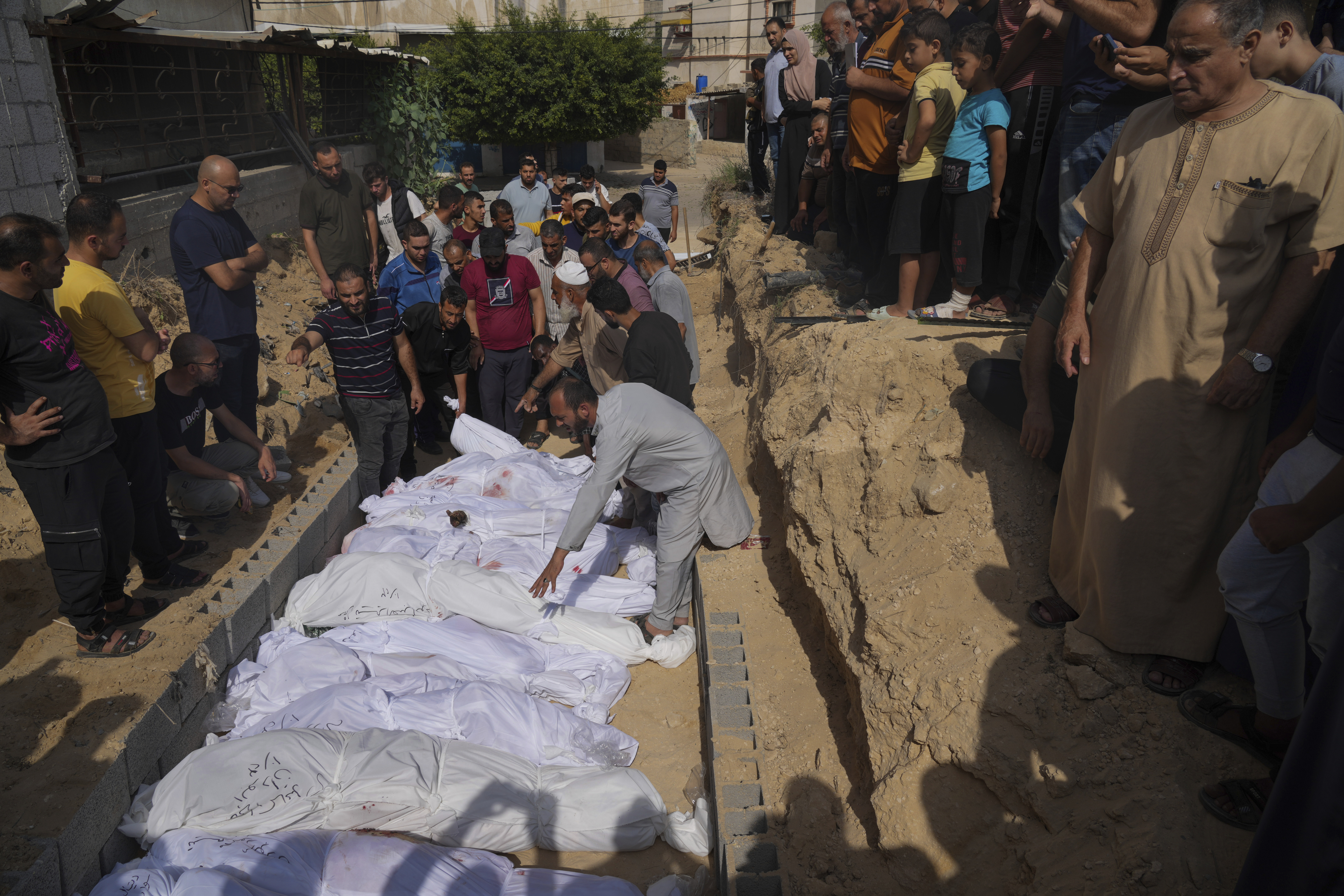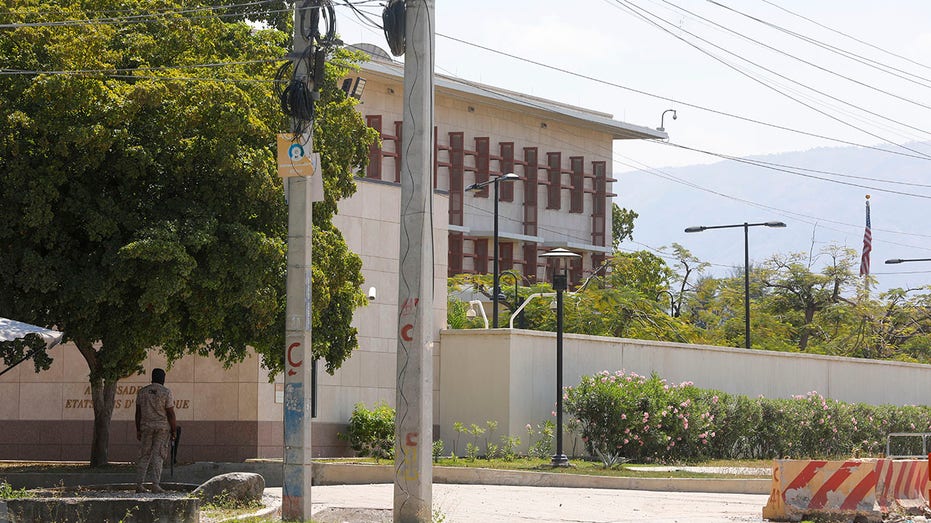Israel launches 400 strikes across Gaza
Health officials say hundreds of Palestinians have been killed.


RAFAH, Gaza Strip — A barrage of Israeli airstrikes across the Gaza Strip on Tuesday crushed multiple residential buildings and buried families under rubble, as health officials in the besieged territory reported hundreds killed in the past day and the closure of medical facilities because of bomb damage and a lack of power.
The soaring death toll from Israel’s escalating bombardment is unprecedented in the decadeslong Israeli-Palestinian conflict. It augurs an even greater loss of life in Gaza once Israeli forces backed by tanks and artillery launch an expected ground offensive aimed at crushing Hamas militants.
Gaza’s 2.3 million people have been running out of food, water and medicine since Israel sealed off the territory following the devastating Oct. 7 attack by Hamas on towns in southern Israel.
The Gaza Health Ministry, which is run by Hamas, said Israeli airstrikes killed at least 704 people over the past day, mostly women and children. The AP could not independently verify the death tolls cited by Hamas, which says it tallies daily figures from hospital directors.
Israel said Tuesday it had launched 400 airstrikes over the past day, killing Hamas commanders, hitting militants as they were preparing to launch rockets into Israel and striking command centers and a Hamas tunnel shaft. Israel reported 320 strikes the day before.
Scenes of rescuers pulling dead and wounded out of large piles of rubble from collapsed buildings were repeated in main towns of central and south Gaza, where Israel had told civilians to take shelter. Graphic photos and video shot by The Associated Press showed rescuers digging to unearth small bodies from the ruins.
A father knelt on the floor of the Al-Aqsa Hospital in Deir Al-Balah next to the bodies of three dead children cocooned in bloodied sheets. Later at the nearby morgue, workers prayed over 24 dead wrapped in body bags, several of them the size of small children.
Buildings collapsing on residents killed dozens at a time in several cases, witnesses said. Two families lost a total 47 members in a leveled home in Rafah, the Health Ministry said.
A strike on a four-story building in Khan Younis killed at least 32 people, including 13 members of the Saqallah family, said Ammar al-Butta, a relative who survived the airstrike. He said there were about 100 people sheltering in the building, including many who had evacuated from Gaza City.
“We thought that our area would be safe,” he said.
Another strike destroyed a bustling marketplace in the Nuseirat refugee camp in central Gaza, witnesses said. AP photos showed the floor of a vegetable shop covered with blood.
In Gaza City, at least 19 people were killed when an airstrike hit the house of the Bahloul family, according to survivors, who said dozens more people remained buried. The legs of a dead woman and another person, both still half buried, dangled out of the wreckage where workers dug through the dirt, concrete and rebar.
The Hamas-run health ministry says more than 5,700 Palestinians have been killed in the war, including some 2,300 minors. The figure includes the disputed toll from an explosion at a hospital last week.
The fighting has killed more than 1,400 people in Israel — mostly civilians slain during the initial Hamas attack, according to the Israeli government.
As the death toll in Gaza spiraled, facilities to deal with the casualties were dwindling. More than half of primary health-care facilities, and roughly one of every three hospitals, stopped functioning, the World Health Organization said.
Gaza’s five main hospitals were all filled beyond capacity, the territory’s health ministry said.
Hospital staff struggled to triage cases as constant waves of ambulances and private cars carrying wounded pulled up to hospital doors. The Health Ministry said many wounded are laid on the ground without even simple medical intervention and others wait for days for surgeries because there are so many critical cases.
While Israel has allowed a small number of trucks filled with aid to enter, it has barred deliveries of fuel to Gaza.
The rising toll has made it hard for Palestinians to bury the huge numbers of dead, with cemeteries being forced to excavate and reuse old plots and bury up to five bodies in one grave.
“Bodies pour in by the hundreds every day. We use every empty inch in the cemeteries,” said Abdel Rahman Mohamed, a volunteer who helps transfer bodies to Khan Younis’ main cemetery.
Israel says it does not target civilians and that Hamas militants are using them as cover for their attacks. Palestinian militants have fired over 7,000 rockets at Israel since the start of the war, Israel said, and Hamas said it fired a new barrage Tuesday morning.
“We continue to attack forcefully in Gaza City and its environs, where Hamas is building up its terrorist infrastructure, where Hamas is arraying its troops,” said Israeli military spokesman Rear Adm. Daniel Hagari. He again told Palestinians to head south “for your personal safety.”
On Monday, Hamas released two elderly Israeli women who were among the more than 200 people Israel says were taken to Gaza during the attack.
Appearing weak in a wheelchair and speaking softly, 85-year-old Yocheved Lifshitz told reporters Tuesday that the militants beat her with sticks, bruising her ribs and making it hard to breathe as they kidnapped her. They drove her into Gaza, then forced her to walk several kilometers on wet ground to reach a network of tunnels that looked like a spider web, she said.
Once there, though, her treatment improved, she said.
Lifshitz and 79-year-old Nurit Cooper were freed days after an American woman and her teenage daughter were released. Hamas and other militants in Gaza are believed to have taken roughly 220 people, including an unconfirmed number of foreigners and dual citizens.
The Israeli military dropped leaflets in Gaza asking Palestinians to reveal information on the hostages’ whereabouts. In exchange, the military promised a reward and protection for the informant’s home.
Israel has vowed to destroy Hamas. Iranian-backed fighters around the region are warning of possible escalation, including the targeting of U.S. forces deployed in the Mideast, if a ground offensive is launched.
The U.S. has told Iranian-backed Hezbollah in Lebanon and other groups not to join the fight. Israel and Hezbollah have traded fire almost daily across the Israel-Lebanon border, and Israeli warplanes have struck targets in Syria, Lebanon and the occupied West Bank in recent days.



